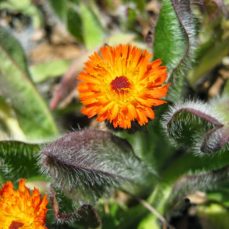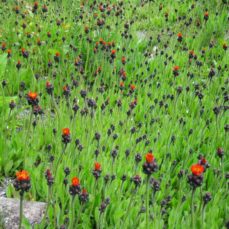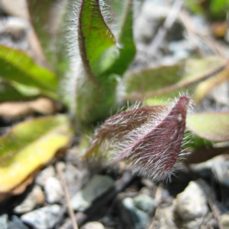
Photo credit: Dave Steers
Management Category
Squamish
Whistler
Pemberton
Vectors of Spread
Synonyms
- Devil’s paintbrush
- Fox-and-cubs
- Orange red king devil
- Red daisy
- Orange paintbrush
- Tawny hawkweed
- Missionary weed
- Grim-the-collier
ID Characteristics
Fast-spreading, hairy perennial plant, growing up to 60 cm tall.
Flowers: Deep orange to red dandelion-like flower clusters which fade to yellow at the centre, atop slender unbranched stems.
Stems: Stems are covered with black, bristly hairs. They produce a milky sap when broken.
Leaves: The hairy, spatula-shaped, toothless leaves are arranged in a rosette. Few to no leaves are found on the stem.
Roots: Orange hawkweed roots are comprised of above-ground (stolons) and below-ground (rhizomes) runners that root and grow new plants.
Fruit: Dark seed with a white hair tuft (pappus).
Similar Species
Native
Orange Hawkweed is one of 14 non-native hawkweed species in BC; there are no orange flowering hawkweeds that are native to BC.

Scarlet paintbrush (Castilleja spp.): a native wildflower that can be many colours including orange and red.

Photo credit: Mary Ellen (Mel) Harte, Bugwood.org
Orange agoseris, also called orange false dandelion (Agoseris aurantiaca), is also sometimes confused for orange hawkweed. However, it has a taproot, unlike orange hawkweed which has runners and stolons. Another easy way to differentiate these orange flowers is that orange hawkweed often has a cluster of flowers at the end of a stem whereas orange agoseris only has one.
Habitat and Origin
Originally from Europe, orange hawkweed was introduced to the U.S. as an ornamental prior to 1818. It also likely made its way to North America as part of contaminated pasture seeds.
Orange hawkweed is generally found in subalpine meadows and pastures. It flourishes in well-drained, coarse-textured soils and can invade natural open areas and disturbed sites, including roadsides, pastures, and clearings.
How it Spreads
This plant spreads through seeds, which are dispersed in the wind. Orange hawkweed also reproduces vegetatively by above-ground runners called stolons, and below-ground roots called rhizomes. One orange hawkweed plant could infest an area of up to 1 m in diameter.
Orange hawkweed spreads by seed, rhizomes, stolons, garden waste, soil, machinery, and footwear. It is also sold as an ornamental.
Impacts
Ecological:
- Forms dense mats that outcompete native species, reducing biodiversity.
- Drastically changes vegetation structure.
- Reduces availability of forage for livestock.
- Produce chemicals which inhibit the growth of native plants (allelopathic properties).
Economic:
- As desirable forage plants are replaced by this somewhat unpalatable weed, productivity decreases and land values drop.
Stop the Spread
Orange hawkweed is abundant in the Sea to Sky region, but has not yet infested all potential habitats. The goal is to contain and control the spread.
- Regularly monitor properties for weed infestations.
- Remove plant material from equipment, vehicles or clothing used in infested areas and wash equipment and vehicles at designated cleaning sites before leaving infested areas.
- Ensure soil and gravel are uncontaminated before transport.
- Minimize soil disturbances (e.g., use grazing plants that prevent soil exposure from overgrazing), and use seed mixes with dense, early colonization (e.g., alfalfa or barley) to re-vegetate exposed soil and resist invasion.
- Ensure invasive plants (particularly flowering heads or root fragments) are bagged or covered to prevent spread during transport to designated disposal sites (e.g., landfill). Do NOT compost.
Control
Cultural Control
In soils with low nitrogen and sulphur levels, the competitive ability of grasses can be increased by applying a fertilizer with nitrogen and sulphur components.
Mechanical Control
- Hand-pull or dig when soil is moist.
- Remove all flower heads and buds from the site since they will continue to mature even after the plant is pulled.
- Mechanical control of orange hawkweed has had limited success since disturbing the stolons and rhizomes may only help the plant to spread.
- Although mowing prevents seed production by removing flowering stems, repeated mowing encourages faster vegetative spread.
Chemical Control
- Orange hawkweed is effectively controlled by dicamba, clopyralid, picloram, and picloram + 2,4-D.
- However, picloram is not suitable for wet, coastal soils.
- Complete eradication is unlikely, so a follow-up with fertilizer and top dressing is required.
We recommend that any herbicide application is carried out by a person holding a valid BC Pesticide Application Certificate. Before selecting and applying herbicides, you must review and follow herbicide labels and application rates; municipal, regional, provincial and federal laws and regulations; species-specific treatment recommendations, and site-specific goals and objectives.
Biological Control
No biocontrol is available at this time; more research is required.
Sea to Sky Distribution
Orange Hawkweed Factsheet
Having trouble viewing the factsheet? Don’t worry, all the information is included on this page. You can also contact us with any questions.
Additional Resources
References
- E- flora BC Orange False Dandelion
- E-Flora BC, Hieracium aurantiacum Orange-Red King Devil
- Fraser Valley Invasive Species Society, Orange Hawkweed
- Invasive Species Compendium (CABI), Pilosella aurantiaca
- Invasive Species Council of BC, Field Guide to Noxious Weeds and Invasive Plants of BC
- Invasive Species Council of BC, Orange Hawkweed
- Metro Van BMP
- Metro Vancouver Factsheet, Orange Hawkweed
- Minnesota Wildflowers (MW)
- United States Department of Agriculture (USDA) Natural Resources Conservation Service, Orange Hawkweed Factsheet
- Wilson, L. M. 2007. Key to Identification of Invasive and Native Hawkweeds(Hieraciumspp.) in the Pacific NorthwestRevised March 2007. B.C. Min. For. Range, For. Prac.Br., Kamloops, B.C.
















